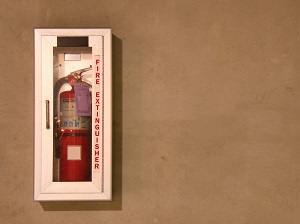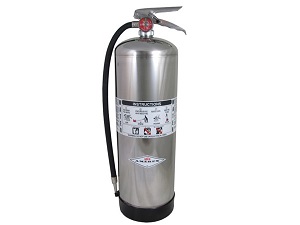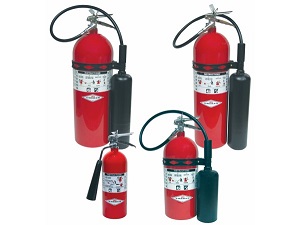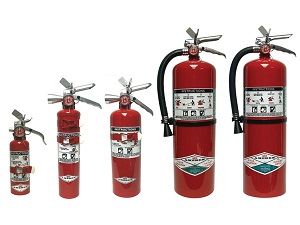Fire extinguishers are classified by the type of fire they are intended to be used on. Explore the different types of portable fire extinguishers that may be available in the workplace that trained staff members may be called on to use in the event of an unexpected fire.

An important part of fire protection involves having the right kind of fire extinguishers at the job site. There are several kinds of portable fire extinguishers that use a variety of extinguishing agents to put out a fire.
In the United States, there are 5 major classifications of fire, known as A, B, C, D and K. Depending on which class of fire ignites will determine how trained personnel act to extinguish the fire. Remember, different types of fire extinguishers are designed to fight different classes of fire.
Fire requires three elements which are fuel, heat and oxygen, known as the fire triangle, and in the right combination the resulting chemical reaction can cause a fire. The key to extinguishing a fire is to remove at least one of the elements from the fire and this is what portable fire extinguishers are designed to accomplish.
Fire extinguishers are classified by the type of fire they are intended to be used on. They can have a classification like A, ABC, BC, D or K that easily explains the type of fire they are designed to fight.
OSHA Standard 1910.157(d)(1) Portable fire extinguishers shall be provided for employee use and selected and distributed based on the classes of anticipated workplace fires and on the size and degree of hazard which would affect their use.
Portable fire extinguishers are labeled with color-coded letters and/or pictograms that indicate the type of fire they are designed to extinguish. There are 5 classes of fire and portable fire extinguishers will be labeled to show they are suitable to fight one or more of these types.
It is critically important that the right type of extinguisher be used on the specific class of fire to avoid personal injury and damage to property. Using the wrong type of fire extinguisher could be ineffective, result in electrical shock, cause an explosion or even spread the fire.
OSHA Standard 1926.352(d) Suitable fire extinguishing equipment shall be immediately available in the work area and shall be maintained in a state of readiness for instant use.
Reminder: Portable fire extinguishers are useful for putting out small fires, but they are not effective against larger fires or fires that are spreading quickly.

The multi-purpose dry chemical fire extinguisher is the most common type of portable fire extinguisher for work and home use.
Dry chemical fire extinguishers put the fire out by interrupting the chemical reaction of the fire triangle. This extinguishing agent creates a barrier between oxygen and the fuel to stop the fire. Typically rated BC or ABC, dry chemical fire extinguishers can be used on two or three different classes of fire, which makes them so convenient.
These multi-purpose fire extinguishers are typically red and range in size from five to 20 pounds.
Because some dry chemical fire extinguishers are only rated for Class B and C fires, it is important to recognize which type (BC vs. ABC) is located in your work area.

An air-pressurized water (APW) fire extinguisher can be used on Class A fires only.
APW extinguishers use water to extinguish the fire by cooling the surface of the fuel to remove the heat element of the fire triangle. In some cases, detergents are added to the water in an APW extinguisher to produce a foam when used.
Filled with water and pressurized air, APW extinguishers are large silver canisters that stand about 2 to 3 feet tall and weigh approximately 25 pounds when full.

A carbon dioxide fire extinguisher can be used on Class B and C fires.
Carbon Dioxide fire extinguishers work by removing the oxygen element of the fire triangle and also by removing the heat with their very cold discharge.
It is not effective to attempt to use a carbon dioxide fire extinguisher on a Class A fire because the fire may continue to smolder and has the potential to re-ignite after the carbon dioxide dissipates.
Never use carbon dioxide fire extinguishers in a confined space if personnel are present without the proper respiratory protection required.

The wet chemical fire extinguisher was developed for use in commercial cooking operations to safely put out Class K fires.
Wet chemical extinguishers work by removing the heat element of the fire triangle as the burning oil is cooled. By also creating a barrier between the fuel and oxygen, the extinguishing agents help to prevent re-ignition after the fire has been put out. With a highly effective spray, wet chemical extinguishers help prevent hot oil from splashing back on the user.
Some wet chemical fire extinguishers can also be used on Class A fires with AK shown on the label to indicate they can be used for both Class A and K fires.

A clean agent fire extinguisher can be rated multi-purpose BC or ABC to conveniently, and cleanly, fight different types of fires.
Because it does not leave a residue upon evaporation, clean agent fire extinguishers may be chosen for industrial facilities that contain sensitive or irreplaceable materials and equipment that could potentially be damaged by a water, foam, carbon dioxide or dry chemical fire extinguisher.

The water mist fire extinguisher may be considered as an alternative to the clean agent extinguisher for sensitive or valuable environments and most are rated for both Class A and Class C fires.
Using de-ionized water (non-conductive and non-toxic), the water mist extinguisher expels water through a unique spray nozzle that releases the water into the air in the form of a fine mist.
Water mist fire extinguishers work by cooling the area to remove the heat element of the fire triangle. Even though they use water to put out a fire, water mist extinguishers don’t cause water damage or leave a residue.

A dry powder fire extinguisher is for Class D or combustible metal fires only.
By smothering the burning material with a dry powder extinguishing agent, the dry powder fire extinguisher works by smothering the fire, separating it from oxygen and absorbing the heat.
Dry powder fire extinguishers (rated D) should not be confused with dry chemical fire extinguishers. Using a dry chemical extinguisher on a Class D fire can increase the intensity of the fire or be ineffective.


.jpg)

.jpg)
.jpeg)